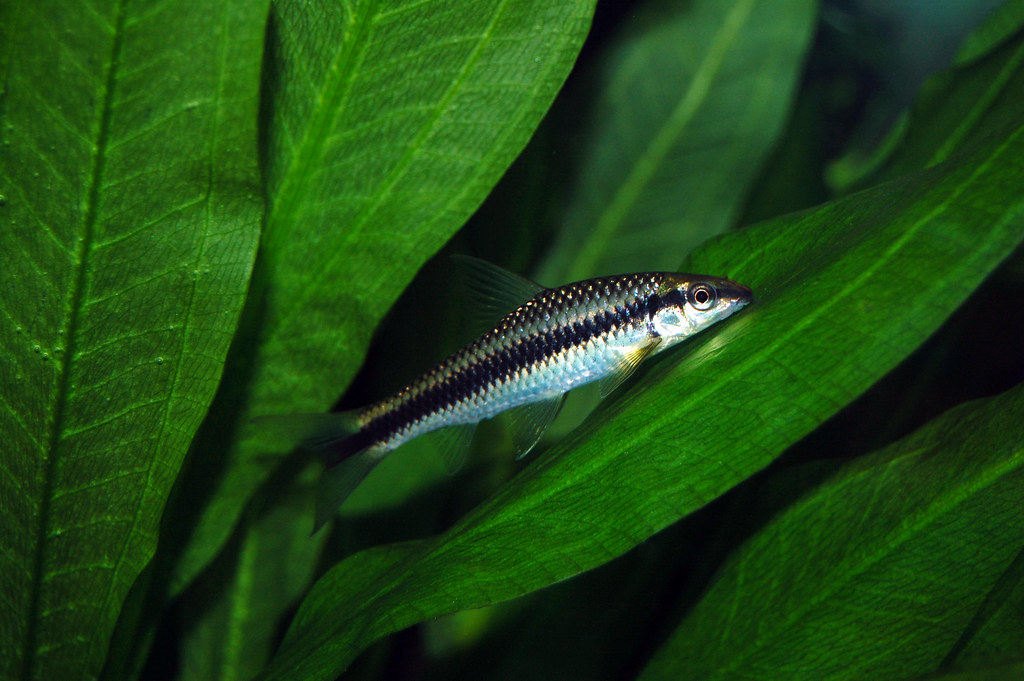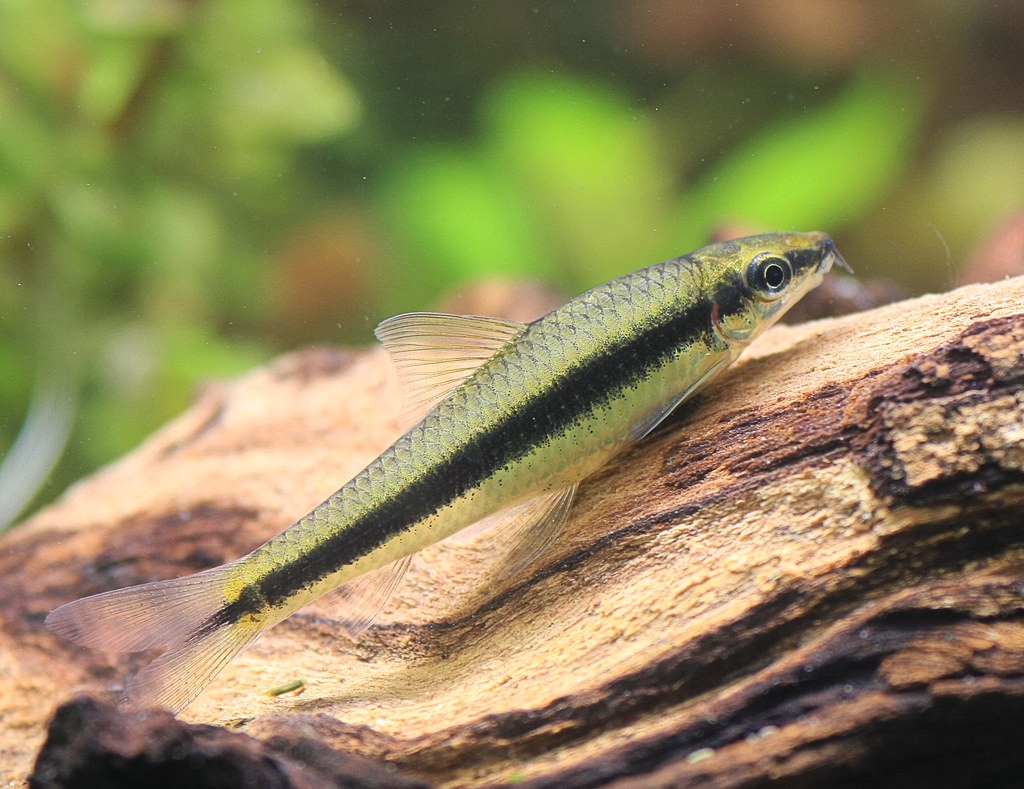Siamese Algae Eater
A popular freshwater fish, the Siamese algae eater – crossocheilus oblongus, is a household name for its knack for consuming algae. Their natural habitat ranges across Southeast Asian rivers such as those in Thailand, the Malayan Peninsula, Mekong, and Chao Phraya. These fish are a favorite among aquarists due to their role in controlling algae growth and therefore improving overall water conditions.
- Experience Level: Beginner
- Hardiness: Hardy
- Minimum Tank Size: 20 gal (75 L)
- Maximum Size: 6 inches (15 cm)
- Temperament: Peaceful
- Temperature: 75 – 80° F (24 – 27° C)
- pH Range: 6.5 – 8
- Water Hardness: 5 – 20 dGH
- Diet: Omnivore
Table of Contents
Introduction
Size and Appearance
Care Guide
Tank Mates
Diet and Feeding
Breeding
The Siamese algae eater can be found in the minor rivers and streams of Southeast Asia, including Thailand, Mekong, and the Malayan Peninsula. These fish occasionally inhabit flooded forests with extremely low pH and negligible water hardness, feasting on the algae found in abundant quantities in these ecosystems. Their favored wild habitats are fast-flowing bodies of water with substrates of sand, pebbles, or boulders. Thanks to their suction-cup-like mouths, they can attach themselves to slippery surfaces and swim swift currents.
Recognized as an unrivaled algae eater, these peaceful creatures serve as fantastic tank cleaners due to their diet of rough algae, which not many fish can handle. Let’s further explore the features of this fish.
Size and Appearance
Siamese algae eaters possess elongated bodies, typically of a silver or pale gray hue. A distinctive black stripe, which blends easily with the surrounding water, decorates their body from head to tail, serving as a form of camouflage against predators. Note that this black line isn’t entirely straight, and a brighter line might be apparent when viewing the fish at an angle.
Their tail fins are semi-transparent, and in contrast to many aquarium fish, they lack a swim bladder, causing them to continuously swim or sink to the bottom. They also have a pair of barbels on their lower lip. Often, the Siamese algae eater is misidentified as its relative, the Siamese flying fox, which is less beneficial in an aquarium.
Distinguishing Siamese Algae Eater from Siamese Flying Fox
Though the two species are often confused, distinct differences exist between them. For instance, the fins of Siamese algae eaters are almost fully transparent except for a speck of black near the tail fin, whereas Siamese flying foxes have a yellowish-orange hue on their fins. Moreover, the Siamese algae eater has a shark-like appearance but remains peaceful, whereas the flying fox features a distinct light golden band with signature black stripes along its flanks.
The average lifespan of a Siamese algae eater in captivity is around 10 years. This longevity is primarily due to their controlled environment, controlled diet, and lack of natural predators. So, to ensure a long life for your fish, ensure you cater to its environment and dietary preferences.
Fully mature Siamese algae eaters can reach up to 6 inches (15cm) in length when properly nurtured. There have been exceptional instances of these fish growing beyond 6 inches, usually observed in individuals raised in more expansive tanks, under ideal conditions, and receiving sufficient nutrition.
Sexual Dimorphism
Identifying gender differences in Siamese algae eaters can be challenging as their sexual indicators are faint. However, a slightly protruding abdomen in female Siamese algae eaters indicates they are ready to breed.
Behavior
Despite their shark-like appearance, Siamese algae eaters are peaceful and energetic creatures, always on the move due to the absence of a swim bladder. This lack of buoyancy means these fish dwell at the bottom layer of the tank. Siamese algae eaters are inherently social and tend to swim in schools of at least five.
Notable behaviors include:
- They sink once they stop swimming.
- Siamese algae eaters can attach to their tank walls using specialized organs in their mouth functioning as suckers.
- Siamese algae eaters prop themselves up with their pectoral fin when at rest.
Siamese algae eaters are standouts among most species of fish, mainly due to their tank cleaning abilities by consuming algae and maintaining a healthy balance within the tank. These fish are relatively low-maintenance, requiring just their basic needs to flourish. Subsequently, they enrich the water quality in the tank. Additionally, Siamese algae eaters enhance the aesthetics of your tank, adding a touch of flair to your setup.
Care Guide
- Minimum Tank Size: 20 gal (75 L)
- pH Range: 6.5 – 8
- Water Hardness: 5 – 20 dGH
- Temperature: 75 – 80° F (24 – 27° C)
- Lighting: Bright to Moderate
- Substrate: Fine sand/gravel, mud
- Brackish: No
- Water Flow: Weak/Low
- Tank Region: Mid to bottom
Proper care and disease prevention are crucial to ensure the health of the Siamese algae eater, a fantastic choice for beginners. When given adequate care and food, these fish can live up to 10 years in captivity. Below we explain a comprehensive care guide for your Siamese algae eater.
The initial challenge in raising a Siamese algae eater is setting up its tank correctly. The ideal tank for Siamese algae eaters should accommodate their size and swimming attributes, requiring a minimum of 20 gallons of capacity, preferably fitted with a cover or hood to prevent any enthusiastic jumps.
For every additional Siamese algae eater, you should add an extra 10 gallons of water. Hence, if you plan on keeping four Siamese algae eaters, a 50-gallon tank is required or 20 gallons for the first fish, and an additional 10 gallons for each of the other three.
Siamese Algae Eaters readily adapt to varying degrees of water hardness on the condition that parameters remain consistent. The preferred pH range for these fish is between 6.5 and 8.0, though they can tolerate acidic conditions down to 6.0.
The Siamese algae eater will thrive at temperatures around 75 to 80℉ – slightly less than a tropical climate. To maintain constant temperature conditions, a water heater is essential.
Regarding substrate choice, soft substrates such as sand and aquatic soils, free from sharp edges, are best for Siamese algae eater as they don’t harm the fish’s abdomen or delicate barbels. Alternatively, a blend of small round pebbles and large, smooth rocks can work. Sharp-edged gravels should never be used.
Similarly, a pristine water environment with high levels of oxygen is needed for these fish to thrive.
Siamese algae eaters can withstand various lighting conditions, coping well with both bright and scattered light. A daily 12-hour period of moderate to low light is ideal. Also, the light requirements of the plants in the tank should be considered.
Including plants in your tank setup offers shelter to the fish and enriches the water with oxygen while keeping it clean. Fast-growing plants are recommended as they can serve as snacks for your fish while quickly regrowing.
Further, adding items such as small tunnels, hollowed-out logs, and swim-in-hide-outs offer necessary shade and hiding spaces, reducing stress and swimming fatigue for your fish. These decorations also provide surfaces for algae and biofilm to grow, becoming a potential food source for the Siamese algae eater.
Tank Mates
Given their peaceful demeanor, Siamese algae eaters are compatible with a wide variety of tank mates, making ideal candidates for community tanks. As these fish inhabit the bottom of the aquarium, selecting tank mates that will not intimidate or bully them is crucial. It’s preferable to opt for peaceful bottom dwellers, like Corydoras, over territorial species, like Redtail sharks.
Size and temperament should also be considered when choosing tank mates from other water layers, thereby eliminating aggressive selections such as Cichlids. Do bear in mind that your tank mate choices are not confined to fish species. Other algae-eating animals can also be added.
Some compatible tank mates for Siamese algae eaters include:
- Tetras
- Danios
- Guppies
- Corydoras
- Amanos
- Shrimp
- Nerite snails
- Barbs
- Angelfish
- Swordtails
- Cory cats
Avoiding Certain Tank Mates
While Siamese algae eaters are active and social, they can bite slow-moving fish or fish with long fins. As such, it’s recommended to avoid pairing them with slow-moving, aggressive or semi-aggressive fish such as:
- Cichlids
- Redtailed sharks
- Tiger barbs
Feeding Guide
- Diet: Omnivore
- Frequency: Several small feedings per day
- Pellet Foods: Yes
- Flake Foods: Yes
- Live Foods: Yes
- Meat Foods: Yes
- Vegetable Foods: Yes
Maintaining a well-balanced diet consisting of high-quality food is vital for the health and life extension of Siamese algae eaters. Being omnivores, they are far from finicky eaters and will consume anything from dead insects and fish to plant matter.
In their natural habitat, Siamese algae eaters dine on various algae types, including Periphyton and phytoplankton, in addition to any deceased insects or fish they encounter. Replicating their diet in captivity as closely as possible to their wild diet will promote optimal health.
• High-quality Commercial Diet: Sinking foods like Spirulina pellets and algae wafers keep the attention of the upper-swimming fish.
• Fresh Veggies: Algae wafers can be switched out for blanched greens such as peas, cucumbers, and spinach.
• Proteins: To maintain nutritional balance, incorporate protein-based foods such as bloodworms, mosquito larvae, daphnia eggs, and brine shrimp into their diet once a week.
Younger Siamese algae eaters typically consume more algae compared to mature ones who favor a protein-based diet. Limiting their food intake to small portions several times a day is advisable. Overfeeding can discourage them from consuming algae, among other issues. Conversely, underfeeding can cause them to snack on other aquarium plants.
All in all, managing the feeding frequency and portioning of food can optimize the health of these fantastic algae eaters.
Breeding
Achieving successful breeding of Siamese algae eaters in an uncontrolled domestic setting can be challenging. It’s yet unconfirmed whether anyone has managed to breed this fish species in the US, possibly because their breeding and spawning behaviors aren’t fully understood.
However, there are claims that Siamese algae eaters have been bred in Asian captivity using hormonal intervention, although the specifics remain unknown. The accessibility of such hormones would be a challenge for home aquarists.
Siamese algae eaters found in pet stores are either bred on fish farms or captured from the wild. It’s highly unlikely that Siamese algae eaters would breed within your home aquarium.



